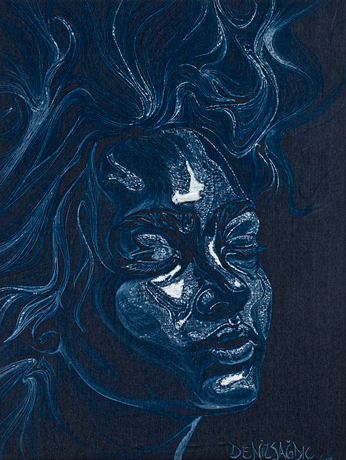Deniz Sağdıç’s path to becoming an artist started in the traditional manner with a degree from Mersin University’s Faculty of Fine Arts in Turkey. Graduating at the top of her class in 2003, she moved to Istanbul to further her career. She quickly drew critical acclaim around the world for her fluid oil paintings and portraits. But soon, she began to dislike the elitism that is associated with traditional styles of art. She found that art galleries and the people who go to them fall into a very narrow segment of society and she wanted to change that. On the Turkish website Dunyabizim she states,
“I realized that it was necessary to find different solutions in order to bring art to a much wider audience.”
Sağdıç was looking for a connection with her audience and as she started to experiment with new mediums she found that people responded the best to items that were familiar like books, cassette tapes, TVs and old windows.
In her project Ready Remade, she combined painting, fabric and found objects to create unique sculptural pieces. But the journey had just begun.
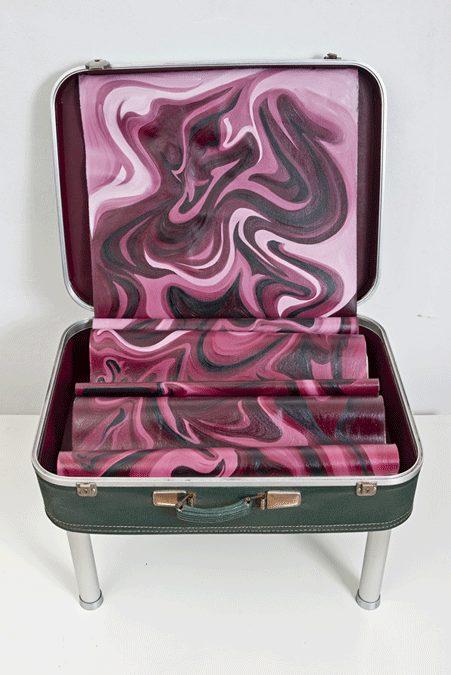
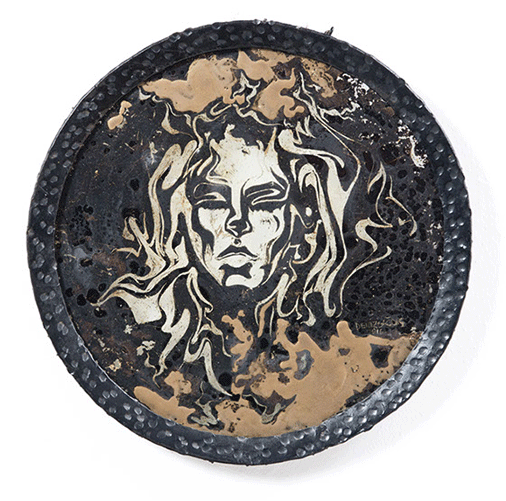
Sağdıç comes from a family of artists and craftspeople. Her father designed stained glass windows and her aunts were tailors. She spent most of her free time growing up in these workshops so it was a natural progression, as she experimented with different mediums, to be drawn to textiles and graphical shapes. It wasn’t long before she discovered the versatility of denim. The fabric of jeans is one of the most widely worn textiles in the world, crossing cultures and classes, and this appealed to her message of accessibility. But as she delved deeper into the history of denim and the current state of the fashion industry, an environmental issue that is global in scale was revealed.
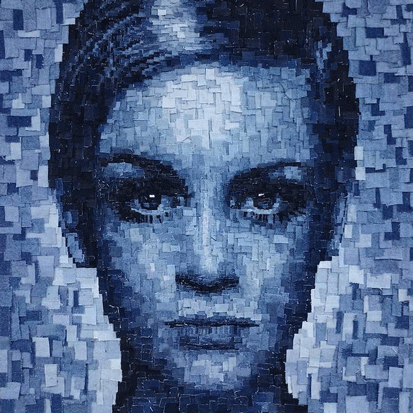
An art industry with an unsustainable rep
The fashion industry is the second worst polluter of clean water just after agriculture according to the United Nations Sustainable Development Goal (SDG) Responsible Consumption and Production. It is just one example in many of how our constant need to buy things is polluting the land and draining the planet’s resources.
Making clothes is hard on the earth from the beginning of its production cycle to the very end. It starts with the production of the fabric.
- It takes 1800 gallons (6800 litres) of water to grow enough cotton for one pair of jeans.
- The cotton that makes up denim also requires enormous amounts of pesticides to produce.
- The making of clothes pollutes our water systems with agricultural runoff and synthetic dyes that are drained into riverways.
- Most denim clothing is produced cheaply in Asia by underpaid labour in unsafe conditions.
- The fashion industry is responsible for 10% of global carbon emissions. That’s more than international flights and maritime shipping combined.
- And as most cotton fabrics are combined with synthetic fibres or elastic, when we wash our clothes, tiny microplastics drain into the wastewater systems and eventually end up in oceans and the ecosystem.
Just like many products in the world today, our clothes are not meant to last. The mass production of cheaply made clothes is known as fast fashion. In our desire to have the latest styles and the fact that the clothes barely last a few cleaning cycles, we throw out 13 million tons of textiles a year.
If we do manage to donate them to a thrift shop charity, only a small portion is sold. Some fabrics can be ground down and recycled into insulation and car seat padding but most are sold overseas to Africa. From there, some are sold cheaply but most end up in their landfills.
There are organizations like Fashion Revolution and brands like Patagonia that are working to turn the tide, but the process is slow. Getting the message out and altering consumer behaviour is critical for change to happen. That’s why Sağdıç’s work is so important.
Turning discarded scraps into new art
When Sağdıç started her denim project she would scour thrift shops in her area. But eventually, as she discovered she needed more material, rather than purchasing virgin denim, she reached out to local clothing production companies. From them, she requests only the remnants (the scraps left from cutting out patterns) and the defective or test pieces. While her understanding of colour, shading and lighting techniques is clear in her scrap piece portraits, her imagination and skill are evident in her creative use of the awkward parts of a pair of jeans, the multilayered seams, belt loops, and metal buttons.
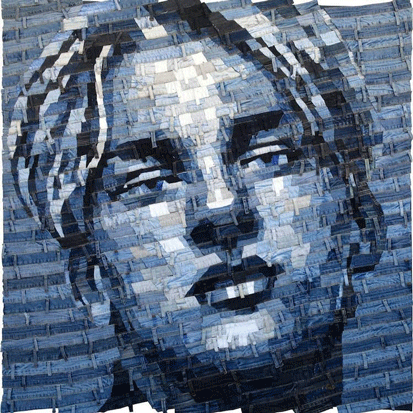
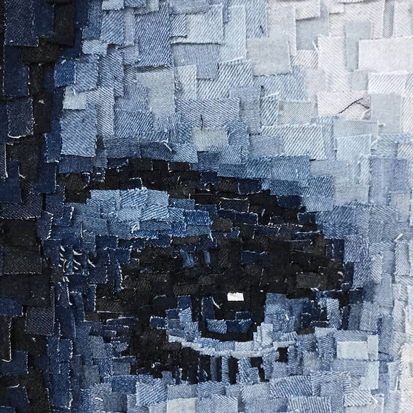
Over time, Sağdıç has developed 8 different approaches to sculpt the fabric into her portraits. Some can take a couple of days, others can take months.
There are only a couple of artists in the world working with this medium. Focusing on portraits and using every part of a pair of jeans, makes her art truly unique.
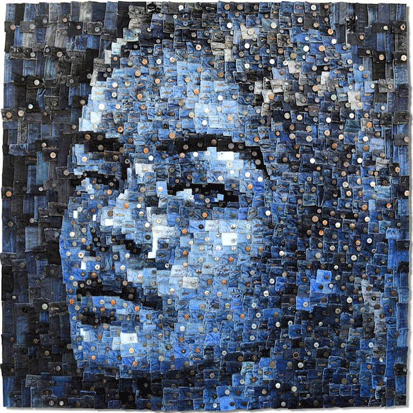
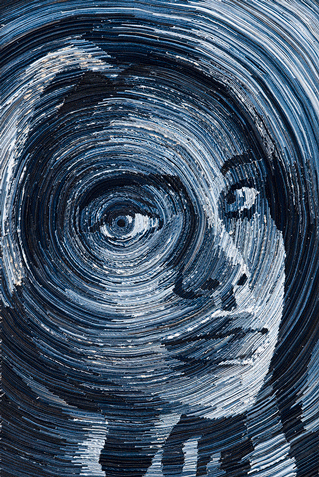
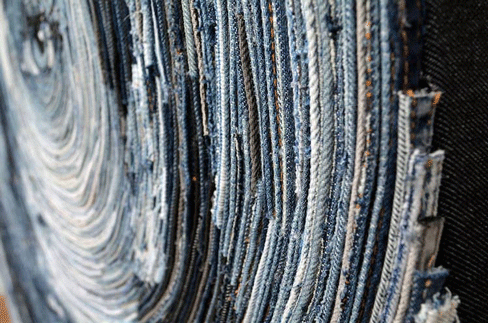
A symbol of democratic art
Sağdıç was attracted to denim for its universality but that wasn’t always the case. The history of denim covers slavery to high fashion. First developed as “slave cloth” for its rough texture and ability to withstand hard labour, it was considered unfit for other members of society. It continued to be associated with a small portion of society when Levi Strauss developed it for gold miners but from there, with the help of movies and the fashion industry, it would expand its reach to people of all classes, ethnicities and cultures around the world. For this reason, Sağdıç sees it as a symbol of democratic art, something that everyone from every background can relate to. At a time when we are still judged by the colour of our skin, the fact that such a universal fabric could perhaps help us get past discrimination is also an important part of Sağdıç’s message.
Continuing the idea of Art: For Everyone, she has chosen to promote her work through workshops, and fashion conferences in Milan, London and Istanbul. Her latest showing was in the YYK’s store window in London. YYK is a well-known zipper manufacturer, who uses its showroom window to promote artists, creating a form of a street gallery. After they displayed Sagdic’s work, many people were seen stopping to get a better look at her intricate designs and take pictures.
Interacting with people is essential to Sağdıç’s art and she likes to collaborate with individuals within each city to create her unique pieces. As she said in an interview with Fashion United about the YYK showroom,
“I use denim not only as a material but also a language.”
By upcycling a medium that expresses cultural universality and positioning her art where anyone can appreciate it, Sağdıç can define her own form of art and at the same time, raise awareness about an industry in desperate need of an environmental overhaul.
To see more of Deniz Sağdıç project Denim Skin, click here.
To keep up to date on her latest creations, follow the artist on Facebook and Instagram.
To learn more about Fast Fashion and what you can do about it, click here.
